On the Saturday after the Charleston church massacre wherein nine worshippers at one of the nation’s oldest black churches were slaughtered during Bible study by a white gunman hoping to ignite a race war, we dragged our kids to the east side to walk them over New York City’s oldest standing bridge. It seemed as good a way as any to kill a weekend afternoon. The High Bridge, which was built with much fanfare in the mid-19th century as part of the Croton Aqueduct system and as a promenade connecting Upper Manhattan to the Bronx over the Harlem River, had recently — and somewhat miraculously — reopened after 40-odd years of disuse. I say “miraculously” because the bridge was an infrastructure most of us had come to accept as blighted, even as some civic groups had coalesced to resurrect it. In the back of our minds that summer of 2015, as an uprising and its violent suppression raged in Missouri, was the problem of when and how to talk to our children about protecting themselves from the police.
At what age is such a conversation appropriate? By what age is it critical? How could it not be despairing? And what, precisely, should be said? The boy was 4 then. The girl, just 2.
The day was hot. En route to the bridge we felt no reprieve from the sun, just as we’d felt no relief from the pileup of bad news about blacks being murdered with impunity. When we learned of the terror at AME Emanuel in Charleston, we had not yet recovered from the unlawful death of Freddie Gray in Baltimore, or the shooting of Mike Brown in Ferguson, or the chokehold death of Eric Garner in Staten Island, or the shooting of Trayvon Martin in Florida, or the shooting of Tamir Rice in Cleveland, to name but a few triggers of civil unrest. We weren’t surprised there were no indictments in these cases, sadly enough, but we were righteously indignant. The deaths seemed to be cascading in rapid succession, each one tripping a live wire, like the feet of Muybridge’s galloping horse.
The picture we were getting — and not because it was growing worse, but because our technology now exposed it — was clear and mounting evidence of discriminatory systems that don’t treat or protect our citizens equally, and escalating dissent was giving rise to a movement that insists what should be evident to everyone: Black Lives Matter. There were hashtag alerts for pop-up protests in malls, die-ins on roads, and other staged acts of civil disobedience such as disruptions of white people eating their brunch. Protesters against police brutality dusted off some slogans from the civil rights era, such as “No justice — no peace!” but others were au courant: “I can’t breathe,” “Hands up, don’t shoot!” “White silence is violence,” and most poignant to me as a mother, “Is my son next?”
“It’s too hot and my legs are too small,” our son protested on the way to the bridge.
The boy was right — it was hot and getting hotter. He was tall for 4 but still so little. When standing at our front door, his nose just cleared the height of the doorknob. He was the same size as the pair of boys depicted in a two-panel cartoon by Ben Sargent circulating widely on my Facebook feed that summer. Both panels depict a little boy at the threshold, on the verge of stepping outdoors. The drawings are nearly identical except that the first boy is white and the second, black. “I’m goin’ out, Mom!” each boy calls to a mother outside of the frame. The white boy’s mother simply replies, “Put on your jacket.” But the other mother’s instructions comprise so intricate, leery, and vexed a warning that her words obstruct the exit: “Put on your jacket, keep your hands in sight at all times, don’t make any sudden moves, keep your mouth shut around police, don’t run, don’t wear a hoodie, don’t give them an excuse to hurt you . . .” and so on until the text in her speech bubble blurs, as in a painting by Glenn Ligon. The cartoon is titled “Still Two Americas.”
I didn’t wish to be her, the mother who needed to say, “Some people will read you as black and therefore X.” Why should I be the fearful mother? Nor did I covet the white mother’s casual regard. I wanted to be the mother who got to say to her children, “Keep your eyes open for interesting details and take notes” as well as “Enjoy yourselves!” on their way out the door.
But for now, I carried our sweaty girl down 173rd Street on my back while my husband led our stubborn son by the hand. You know the thermometer’s popping in Washington Heights when there aren’t any Dominicans out on the sidewalks playing dominoes. Nobody had yet cranked open the fire hydrants. The heat knocked out the girl as if it were a club. The boy was in a rotten mood. He demanded a drink then rejected the water we’d packed. He whined that the walk was too long then challenged our authority in a dozen other hectoring ways until we at last arrived at Highbridge Park. There he refused to descend the hundred stairs to the bridge by flinging himself onto the asphalt with his arms and legs bent in the style of a swastika, not five feet from a dead rat. The kid’s defiance bothered us for all the usual reasons a parent should find it irksome, but also because if allowed to incubate in the ghetto where we live, that defiance could get him killed.
Our son was soon coaxed down the vertiginous stairs by the magical horn of an Amtrak train on the railway beneath the bridge. He has explained to me his fierce attraction to trains and boats and vehicles in general with irritation that I didn’t already know the answer: “They take you somewhere else.” That’s just it. From the time your children begin walking, they are moving away from you. This is as it should be, even when you can’t protect them from harm with anything but the inadequate outerwear of your love.
A sweet old man in seersucker shorts stopped us at the entrance to the bridge to make sure we appreciated the marvel of its rehabilitation. He was something of a history buff and spoke with a European accent — Greek, I think. He could recall when the bridge was shut down after falling into long decline, and the time before that when miscreants and vandals tossed projectiles over the guardrail into the polluted water below or at the traffic on the Harlem River Drive. Thanks to him, I know that the bridge was a feat of engineering originally modeled after a Roman aqueduct, siphoning water from Westchester County through pipes beneath its walkway into the city, enabling New Yorkers to enjoy their first indoor plumbing (including the flush toilet). The old man never thought he’d live to see the day when the High Bridge was back in business, and was proud that the citizen-led campaign to reopen it had succeeded. “This bridge changed everything,” the old man said in wonderment, as if the relic was a truer paean to empire than the skyscrapers twinkling in the skyline far to the south of us — the Chrysler Building, the former Citicorp tower, and the spire of the Empire State. Dutifully, we paraded across to the Bronx. Maybe it was because I so admired the old man’s perspective, attuned as it was to a less conspicuous wonder of the world, that on our return trip home I noticed a mural I could have sworn had not been there before.
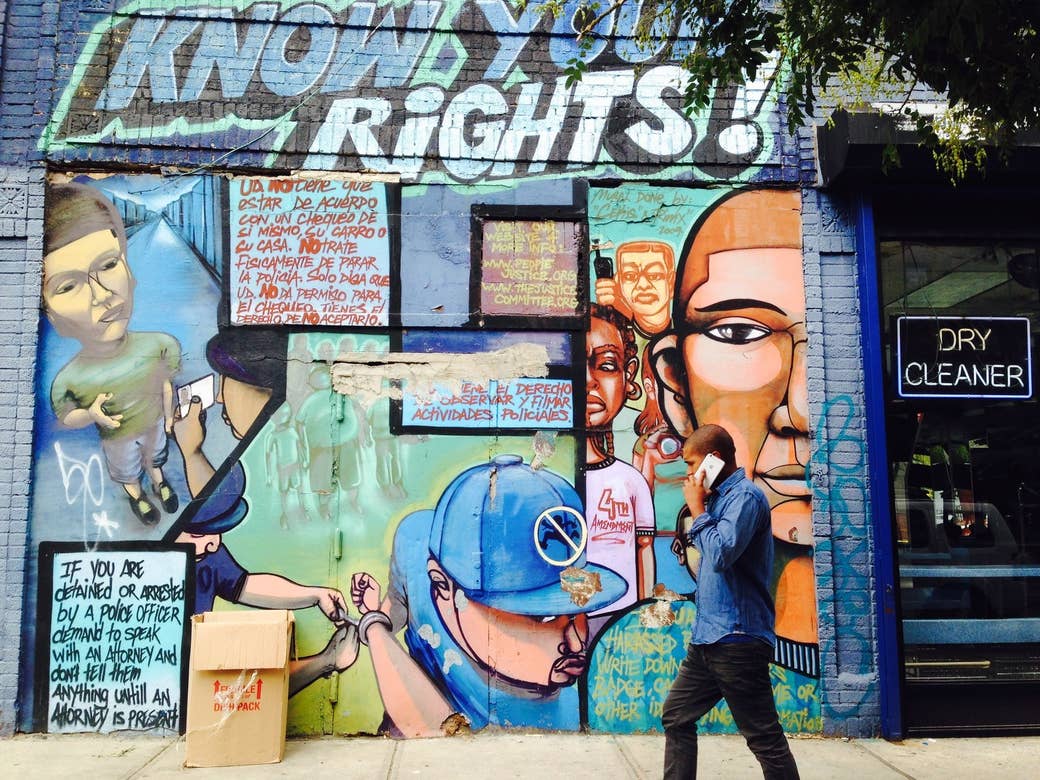
"KNOW YOUR RIGHTS!” the mural trumpeted in capital letters. How had it escaped my attention? The artwork covered a brick wall abutting the 24-hour laundromat I passed every weekday morning on the walk to the children’s day care. A vision of tropical blues, it splashed out from the gritty gray surroundings, creating an illusion of depth. My eyes drank it in.
This mural operates like a comic strip in panels marrying image and text. In the first panel, a youngster is carded by a law enforcement official. In the second, a goateed man in a baseball cap is being handcuffed. In the third, a group of citizens stare evenly outward. One of them wears a look of disgust, and a T-shirt that says, “4th Amendment,” a sly allusion to the part of our constitution that protects us against unreasonable search and seizure without probable cause. Another holds his cell phone aloft to record what is happening on the street. “You have the right to film and observe police activity,” the mural states in Spanish, appropriate for a neighborhood where Spanish is the dominant language and where young men of color are regularly stopped and frisked by the police. In the lower left-hand corner the Miranda rights are paraphrased in English.
My first instinct was to take a picture of the mural so that I could carry it with me in my pocket. I was grateful for it, not only as a thing of beauty on the gallery of the street, but also as a kind of answer to the question that had been troubling us — how to inform our children about the harassment they might face. The mural struck me as an act of love for the people who would pass it by. I understood why it had been made, and why it had been made here in the hood next to a laundromat as opposed to on Fifth Avenue next to Henri Bendel, Tiffany’s, or Saks. It was armor against the cruelty of the world. It was also a salve, to reclaim physical and psychic space. I wondered who had done it.
After some internet sleuthing I discovered the painter was a Chilean artist who goes by the tag name Cekis, and that this mural was the first of several public artworks commissioned by a coalition of grassroots organizations called People’s Justice for Community Control and Police Accountability. The other Know Your Rights murals were spread out across four of New York City’s five boroughs (excluding Staten Island, where a great number of cops live) in poor neighborhoods most plagued by police misconduct. For the rest of that summer and into the fall, I photographed as many of them as I could, like a magpie collecting bright things for her nest.
The second mural I shot was in central Harlem.
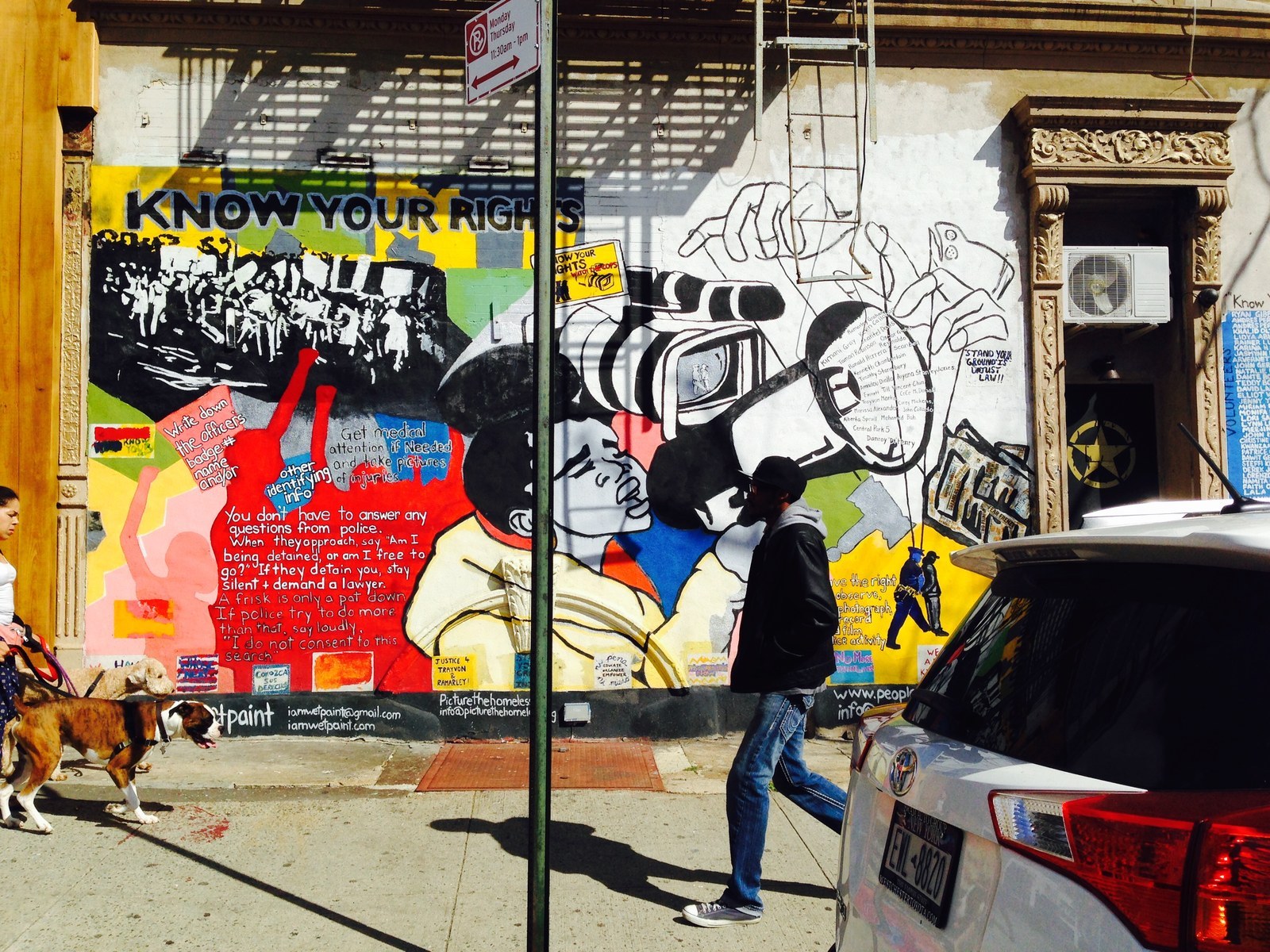
As with the mural in Washington Heights, I chose to capture a passerby in the frame, to give a sense of scale but with the intent to preserve the subject’s anonymity. Thrown against a sharp white background, the man in Harlem appears in silhouette, his beard like Thelonious Monk’s, his shadow extending from his feet, and the shadow of the fire escape above him slanting down against the mural like the bars of a cage. A woman depicted in the mural’s foreground holds a bullhorn to her mouth. A portion of the text reads, “Write down the officer’s badge number, name, and/or other identifying info. You don’t have to answer any questions from police.” Her advice is specifically targeted to those at risk of being stopped and frisked.
Stop-and-frisk policing was implemented in New York as part of an increased trend of enforcement that began in response to rising crime and the crack cocaine epidemic of the 1980s and ’90s. The technique disproportionately affects young men of color. (From 2004 through 2012, African Americans and Hispanics were subject to nearly 90% of the 4.4 million stop-and-frisk actions despite constituting only about half of the city’s population.) In black and Latino neighborhoods like Harlem and Washington Heights, residents often view the police, a force ostensibly there to protect them, with mistrust and fear. In 2013, the year the Harlem mural was made, a federal court judged the use of stop-and-frisk tactics to be excessive and unconstitutional. Since then, their use has declined. Critics of reducing the practice predicted a rise in crime. Instead, overall crime has dropped. I would like to believe these statistics mean it’s growing slightly safer for my children to walk.
Yul-san Liem, who works for one of the activist organizations that makes up People’s Justice, explained to me that the murals were financed by the Center for Constitutional Rights. “Visual art communicates differently than the written or spoken word,” she commented. “By creating Know Your Rights murals, we seek to bring important information directly to the streets where it is needed the most, and in a way that is memorable and visually striking.”
People’s Justice formed in 2007 in the wake of the NYPD killing of the unarmed black man Sean Bell the day before his wedding. “It wasn’t an isolated incident,” Liem lamented, recalling the 1999 killing of Amadou Diallo, the unarmed black man shot 41 times by police, and the assault of Abner Louima, who was sodomized by police with a broomstick in 1997 and allegedly told, “Take this, nigger!” Liem said, “Our original goal was to highlight the systemic nature of police violence in communities of color. We’ve taken a proactive approach to empowerment that includes organizing neighborhood-based Cop Watch teams and outreach that uses public art as a means of education. It’s about shifting culture and creating hope.”
Maybe that’s what I was scavenging for. Hope. I like how Emily Dickinson defined it—“the thing with feathers.”
The third mural that I shot was in Bushwick, Brooklyn. I had difficulty finding it, in part because Bushwick is a neighborhood of murals but also because Liem had given me bum directions. I lost myself in the rainbow spectacle of street art. There was Nelson Mandela on a wall overlooking the parking lot of a White Castle, but where was the mural I sought? I asked a group of kids in Catholic school uniforms if they knew where I could find it. They all claimed to know the Know Your Rights mural, but none could give me an exact address. Either it was somewhere down Knickerbocker Avenue or else it was located in the opposite direction past three or four schoolyards and a car wash. In the end, one girl kindly volunteered to walk me there. She wore a purple backpack, braces on her teeth, and a gold name necklace that said coincidentally (or not) “Esperanza.” Esperanza told me with excitement that she’d be getting an iPhone like mine for her 13th birthday. After perambulating for a half an hour we finally located the mural in an overgrown lot behind a chain-link fence. We’d had so many false sightings at that point that I sensed it was part of the girl’s mental, rather than physical, landscape. It rose out of the weeds in pastel shades like an enormous Easter egg. “I love this one,” she confessed. “It’s so big.”
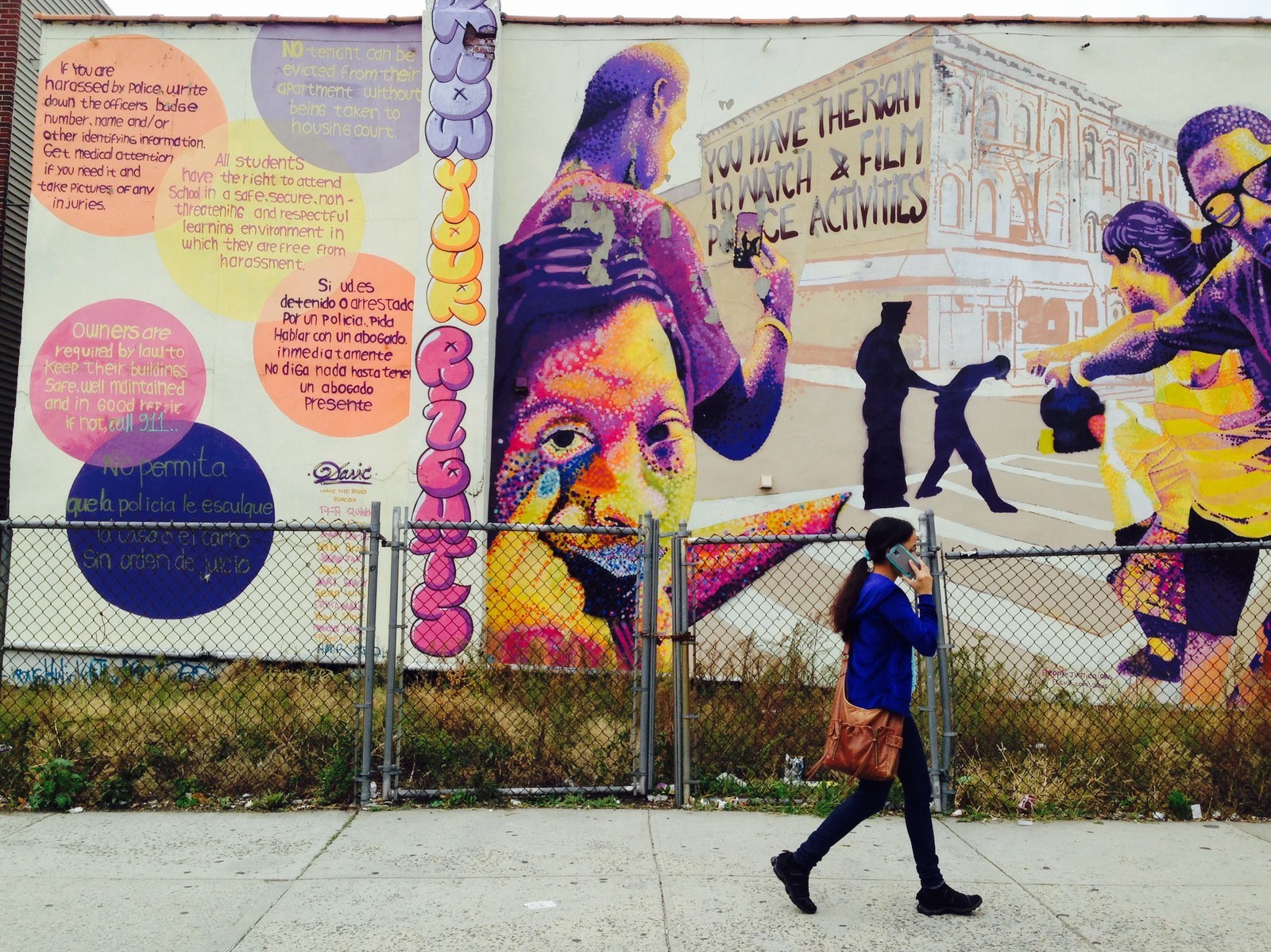
As with the murals in Washington Heights and Harlem, the text of the Bushwick mural exhorts the viewer to watch and film police activities. This time the message is underscored by a figure in the foreground who points to her enormous eye as if to say, “Watch out. Keep your eyes open.” A man directly behind her uses his phone to film a police officer making an arrest in the mural’s background. The phone is configured as a weapon for social change. The teenager that I photograph walking past the mural is also on the phone. Though she appears oblivious to the mural she also appears, in the context of my photo, to be wielding a tool. That is, the phone distracts her from being present but she could also deploy its camera at any moment to record what’s happening on the street.
The fourth mural that I shot was painted on a corrugated fence in Long Island City, Queens, across from the Ravenswood housing projects. On my way through the projects I passed a barefoot lady in a fabulous church hat pushing a stroller full of cans. She was involved in a heated argument over a MetroCard with a man invisible to me. In the middle of an invective she stopped to tell me he was a lying thief. “I believe you,” I said, emphatically. “He’s a jerk.” We smiled at each other. She returned to her dispute and I went on my way.
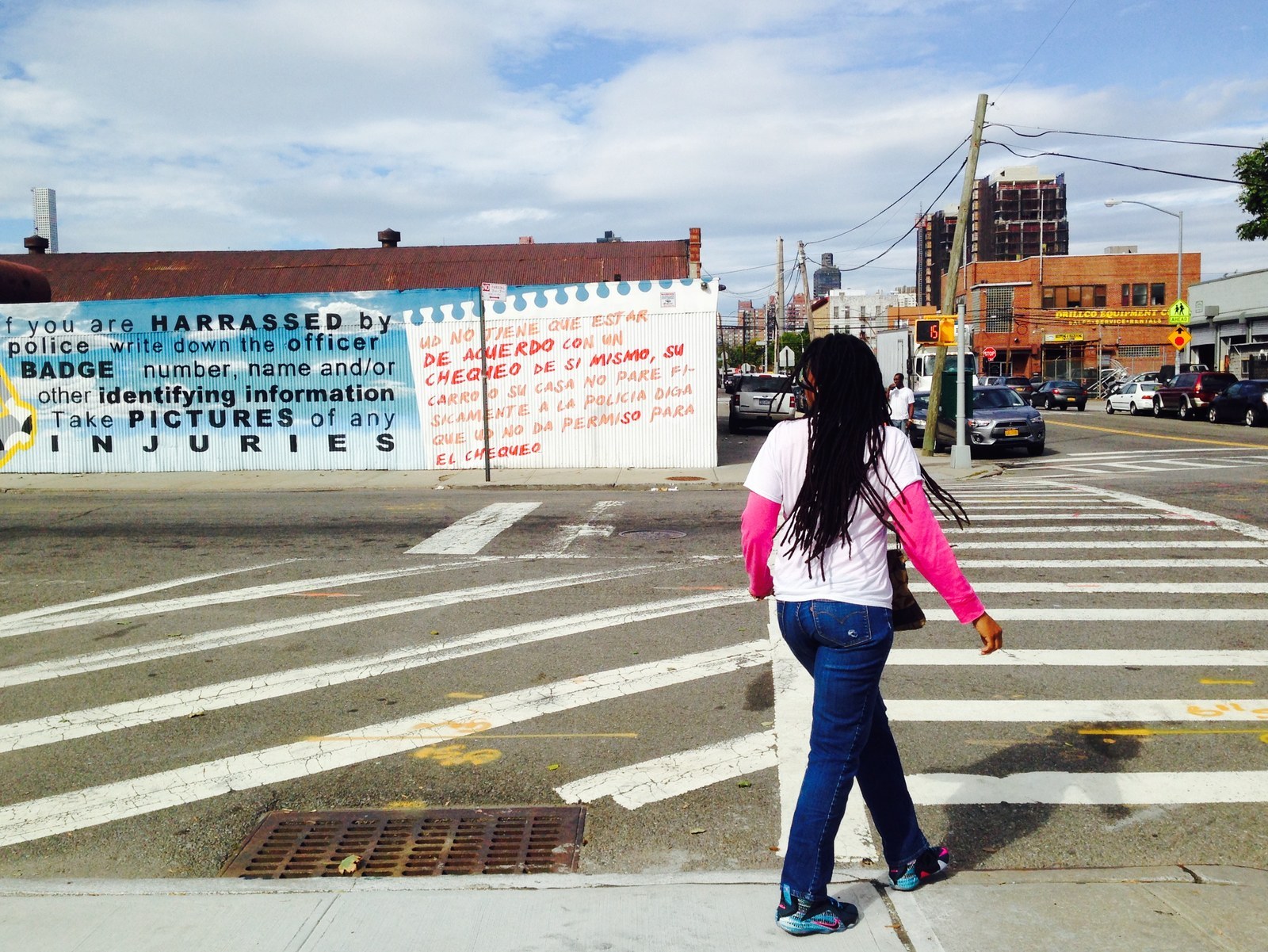
"If you are harassed by police,” the Long Island City mural advises, “take pictures of any injuries.” Again, the mural forms a backdrop for the people walking by — but in this case, because it consists entirely of text, the message is even starker. A woman is about to cross the street. I don’t know where she’s going, or what she’s looking at. She may be checking for oncoming traffic or reading the warning on the mural. Her braids swing across her back as her sneaker approaches the curb. My friend Garnette Cadogan has written, “Walking is among the most dignified of human activities.” But here, the woman’s simple dignified act of walking, whether home from work or school, or to the bodega for a carton of milk, is erupted by the somber memo that hangs in the background. The public space feels contested and even traumatic because of the public art. The intersection looks hazardous, like something is about to hit her.
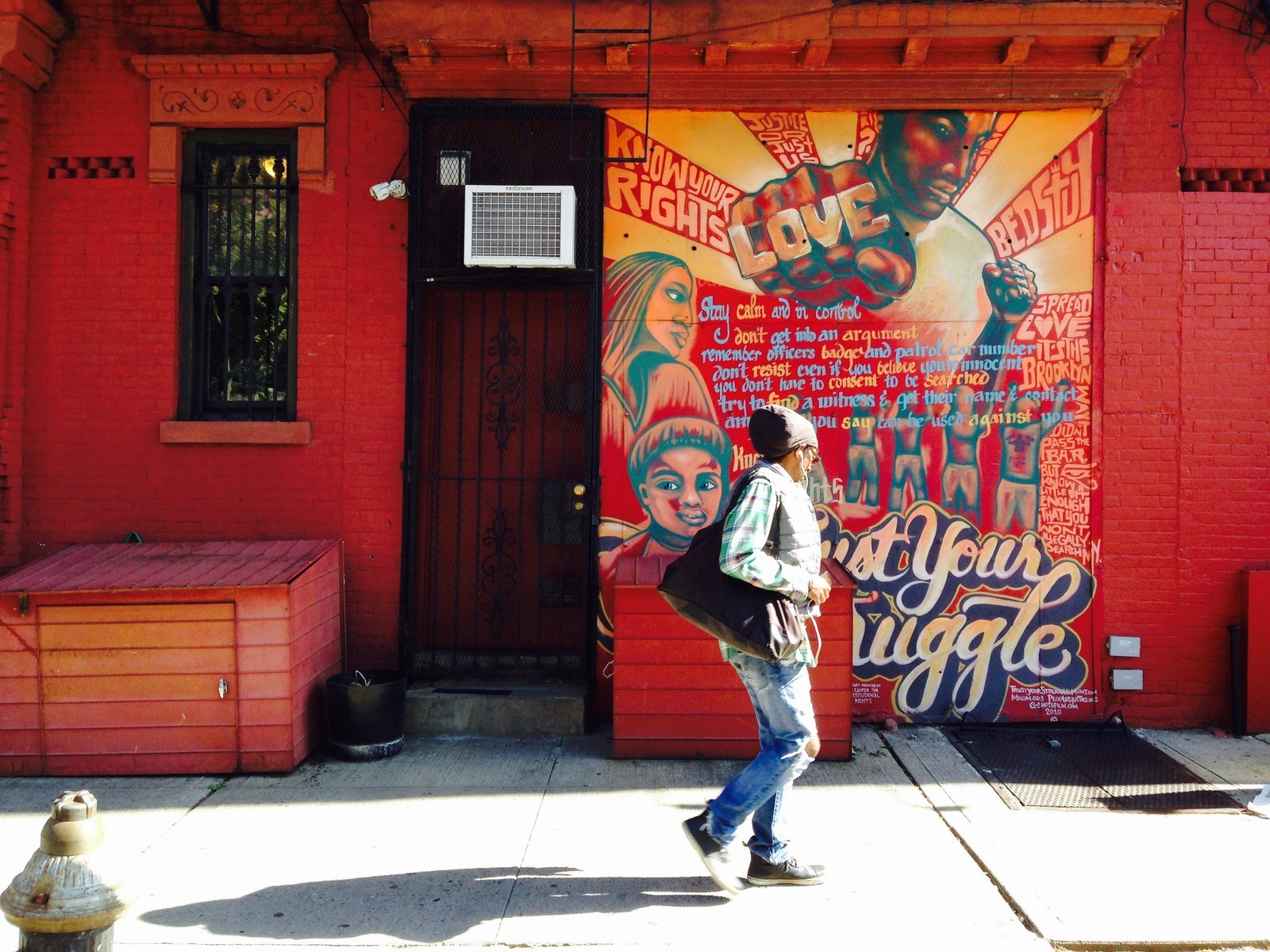
The fifth mural I shot was in Bedford-Stuyvesant, the swiftly gentrifying Brooklyn neighborhood made famous by Spike Lee’s landmark film Do the Right Thing. In fact, the Bed-Stuy mural directly references that movie by depicting the character Radio Raheem. At the start of the movie, Radio Raheem blasts Public Enemy’s “Fight the Power” from his boombox like a reveille. Near the movie’s end, he’s choked to death by a nightstick-wielding cop — a pivotal plot point that incites a riot, much like the uprisings that followed the Rodney King verdict in Los Angeles, and the Freddie Gray verdict in Baltimore, and the Michael Brown verdict in Ferguson, which reverberated across the country like so many waves of heat.
In New York, I remember the Ferguson protesters took to the streets chanting, “Whose streets? Our streets!” I myself was drawn to the vortex of 125th Street, where I shot pictures of the crowd swarming toward the Triborough Bridge. I paused there at the edge of my own reason sometime before midnight to return to my children, but the mob pushed on as far as the tollbooths on the Manhattan side, succeeding in shutting the bridge down. It felt so logical an impulse, to act unruly in the face of misrule. Yet this impulse is what the Bed-Stuy mural admonishes against.
Radio Raheem’s fist is the focal point of the mural, adorned with its gold “LOVE” knuckleplate. The mural, dominated by the color red, cautions the viewer to “Stay calm and in control. Don’t get into an argument. ... Don’t resist, even if you believe you’re innocent.”
The man I photograph walking past the love punch wears paint-splattered work boots, a headcloth over his dreadlocks, and earphones. I wonder what he’s listening to. Perhaps because he’s distracted by his music, he’s unaware that I’ve shot him with my phone.
So was the woman in the Bronx, where I took my sixth and final picture. She was too absorbed by the screen of her device to notice me, though if she looked my way, she would have seen that I too was operating my phone. My posture mirrored the person in the mural who films a plainclothes police officer cuffing a man over the hood of a car. I had to wait over an hour to get this shot because a belligerent drunk pissing on the sidewalk refused to get out of the frame. Finally, he zipped up and drifted off beneath the Bruckner Expressway. Of all the neighborhoods I traversed, Hunts Point felt the roughest. On the long walk to the Point from the elevated 2 train through the red-light district, I was surveyed with interest. I felt that if I wasn’t mindful, someone down on his luck might succeed in snatching my phone. Yet I stayed planted by the mural, looking for something concrete.
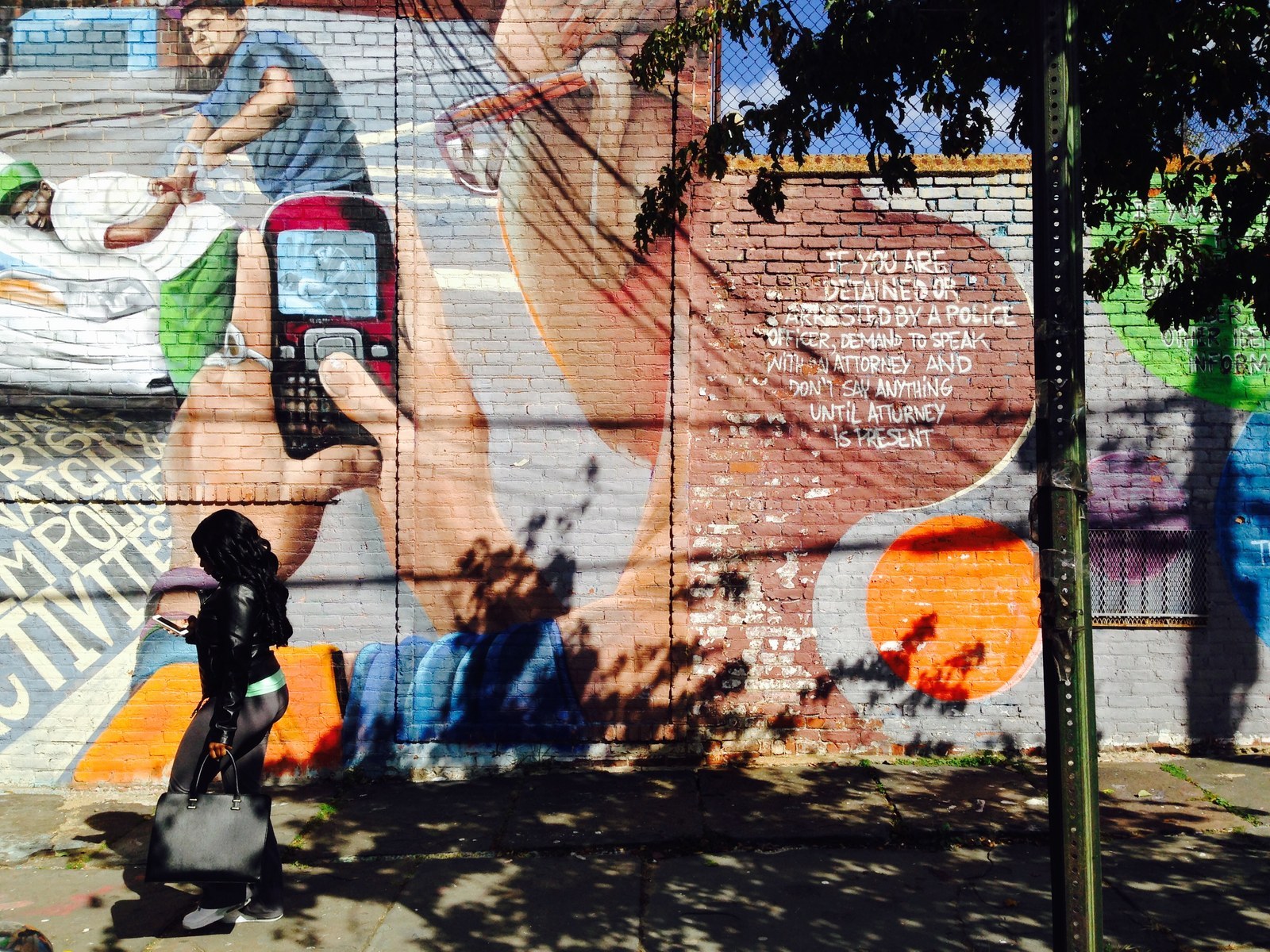
The phone in the Hunts Point mural is almost as tall as the woman walking beneath it, its screen the approximate size of her handbag. In the screenshot we see repeated the nested image of the plainclothes police officer cuffing a man over the hood of the car. The dizzying effect of the mural is to put the viewer in the perspective of the photographer.
I have fallen into the mural — or rather, the mural has sucked me in. I am the third dimension; the watcher. I am the photographer with the phone in her hand. So, potentially, is the passerby, though in this context her posture is also a reminder that passivity has its cost. The woman is about to step out of my frame. For now she is caught, as in a web, by the shadows of power lines and trees. The text behind her echoes that of the first mural I shot on the streets of Washington Heights: If you are detained or arrested by a police officer, demand to speak with an attorney and don’t say anything until the attorney is present.
It was as if the text was on a loop. I’d begun to feel I was moving in circles and so I stopped to take stock of my pictures, scrolling backward. Though the style of each mural was distinct, the message was the same. Somebody loves you enough to try to keep you safe by informing you of your rights. The murals’ insistence on those rights, which the citizens of our nation don’t yet equally enjoy, reminded me that like the High Bridge, the Constitution was just another lofty infrastructure in need of rehabilitation. Such changes do occur, it seems. Were it not for the fact that I shot them in different locales, I felt I could craft a zoetrope of the passersby to show my children. The many walkers would appear unified as one — even if at times that walker was a woman or a man, or black, or brown, or old or young — advancing toward one steady goal. “Look how marvelous,” I would say of the moving image. And if my children asked me where the walker was going, I would answer, “To the bridge.”
This piece is drawn from the forthcoming anthology The Fire This Time, edited by Jesmyn Ward, out from Scribner on Aug. 1, 2016. Photographs of the murals are used with permission from People's Justice for Community Control and Police Accountability.
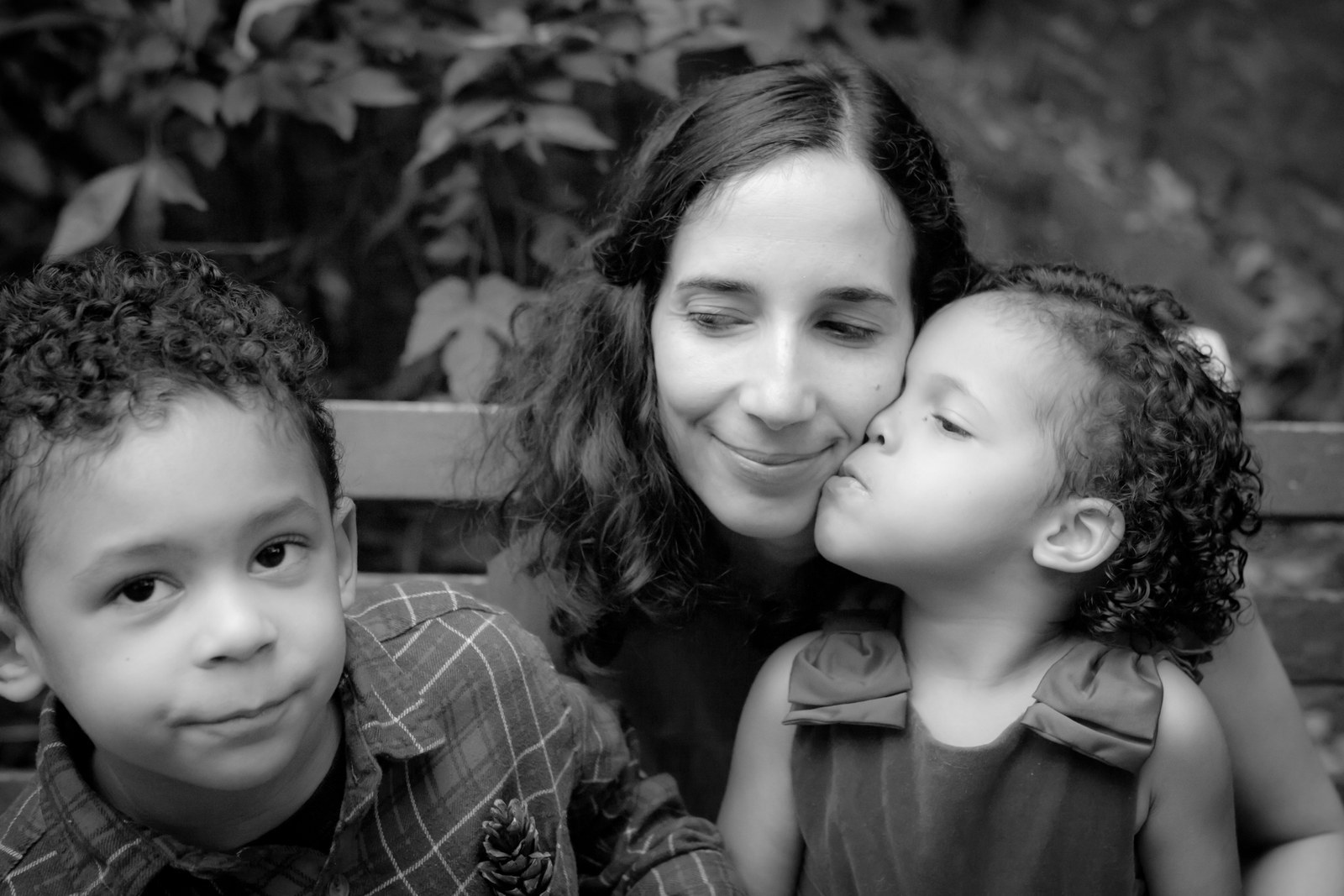
Emily Raboteau is the author, most recently, of Searching for Zion: The Quest for Home in the African Diaspora, winner of an American Book Award. She co-directs the MFA Program in Creative Writing at the City College of New York, in Harlem.
